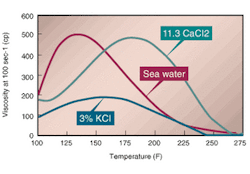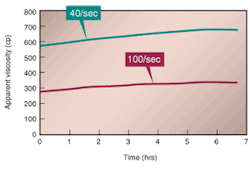Non-ionic fracture fluids can recover 90% permeability after proppant run
For many years, fracturing technology has centered around the chemistry and properties of a wide array of polymers such as guar, hydroxypropyl guar (HPG), and hydroxyethylcellulose (HEC). Since high viscosities are needed to carry the required amount of proppant, high concentrations of polymer are used.
At high polymer concentrations, several potentially serious problems can occur. The most serious is formation and proppant pack damage, due to unbroken gel in the pore throats. As fracturing technology was applied to the offshore environment, different job design criteria were needed for frac packs and tip screen-out (TSO) procedures. Formation damage also became a more serious concern, due to higher permeabilities.
To alleviate many of these potential problems and conserve time and offshore rig space, development began on a series of polymer-free fluids designed to meet the basic requirements of successfully fracturing and stimulating formations. Polymer-free systems can be virtually non-damaging to the formation. Since the polymer-free fluids rely on a different mechanism to create viscosity, job design and operational procedures are adjusted and simplified compared to jobs using polymer fluids.
Recently, Baker Hughes introduced a product called SurFRAQ, a non-ionic surfactant that overcomes many problems with both polymer and polymer-free systems. This two-component fluid system has been shown to have good viscosity and proppant transport capability at temperatures over 200°F. Experimental data indicate that over 90% permeability recovery can be achieved after hydraulic fracturing in low-permeability and high-permeability formations. Other attributes of this fluid include ease of mixing, biodegradability, viscosity stability with time and increasing proppant concentration, and complete breakage with oil and mutual solvents. These attributes are beneficial in offshore applications.
Viscosity development
Polymer-free fluids are made from surfactants that form an interconnected network of micelles. These micelles are highly polar in nature, and are stabilized by high salt brines, seawater, or completion brines. The network structure imitates the hydrated polymer fibers, but with much higher efficiency and strength. The viscosity profiles of these fluids are non-Newtonian and viscoelastic in nature, thus the fluids are designated as viscoelastic surfactants (VES). The dynamic range of the non-ionic surfactant is linear over a wide range, without excessive shear thinning at high shear rates.
One feature of these fluids is the apparent viscosity does not decrease with time or shear history. Since the viscosity is created by micelles instead of polymer fibers, there is no physical degradation with time. Constant rheological parameters offer an advantage in both fracture generation mechanics and proppant transport control. The result is a higher level of management, prediction, and planning of the fracture growth.
VES fluids are stabilized by high salt environments, which makes them able to viscosify high salt brines, seawater, and high-density completion brines. Polymer fluids are unable to accomplish this task because they are not stabilized by the high salt environment.
The non-ionic fluid is particularly enhanced by divalent ions, such as calcium and magnesium. While the viscosity can be easily controlled by the concentration of surfactant, the attained viscosities are not as high as those delivered by polymer-based fluids. This feature allows better fracture height control while maintaining high proppant carrying capacity.
Formation damage
One of the more critical aspects of VES-based fluids is the potential for formation damage due to high leak-off. Since these fluids do not form filter cakes, the invasion depth can be proportional to permeability. The fluid could remain in its viscosified state and therefore plug the pores. To combat this potential problem, a pre-flush or over-flush of brine containing 5-10% mutual solvent could be used. Once the VES comes in contact with the mutual solvent, the fluid breaks down and flows back in early production. In some cases, this preflush/overflush treatment resulted in stimulation of the formation in the production direction.
Another potential problem in well completions is damage to the clays within the formation. Various concentrations of this fluid have been tested on core samples containing appreciable clay content. Tests indicated a high degree of compatibility with high clay content formations. The initial permeabilities were measured using 2% KCl (potassium chloride). The high regain permeability values demonstrate that this non-ionic VES fluid does not adversely affect high clay content formations. Should additional clay control be desired, clay stabilizing additives or a higher concentration of KCl could be added to the fluid without adversely affecting the fluid's viscosity.
Shale stability in gravel pack applications also is a concern. Mechanical testing has shown that VES fluids could be used to stabilize shales, partly because the micellular structure of the fluid minimizes osmotic penetration into the shale, thereby preventing swelling. The fluid does not affect the return permeability of the filter cake or the formation, nor does it affect the gravel pack process.
Good post-stimulation permeability recovery for oil-saturated cores has been reported for VES fluids.
Studies performed with this fluid in oil-saturated cores also showed excellent clean-up results. The high degree of compatibility with oil in this fluid is attributed to the non-ionic nature of the surfactant, which also diminishes the tendency to form emulsions upon breaking. Some crude oils, however, require the use of non-emulsifiers to obtain 100% regained permeability. In such cases, the non-ionic VES fluid has shown good compatibility with demulsifying agents.
Fluid leak-off tests show this fluid behaves similar to a wall-building fluid as permeability decreases. Below 200 mD (milli-Darcies), leak-off coefficient and spurt loss values can be determined. Studies are under way to extend the use of this fluid to unconsolidated, high permeability sands by adding soluble fluid loss additives.
Research shows that fracturing unconsolidated formations with polymer-based fluids can result in extensive formation damage due to the presence of numerous sub-parallel fractures and shear planes enveloping the propped fracture. Because the dehydrated polymer remaining in these small, unpropped fractures after closure cannot be adequately broken, production barriers are formed.
Due to the inherent non-damaging nature of the VES fluids, the effect of such sub-parallel fractures on productivity can be alleviated as the VES is removed during production. Regained permeability studies in unconsolidated rocks have shown that 95-100% of the injected gelled fluid returns when pumped in the production direction.
Proppant transport
One of the unique features of VES fluids is their outstanding ability to transport solids regardless of low apparent viscosity. This is in part due to the net-like structure of the micelle network. In comparison to polymer systems, VES fluids show superior performance in both static and dynamic settlings. One conclusion is that proppant settling increases rapidly with decreasing concentration. While this may be true in a static situation, in practice 1% concentrations have been used successfully to carry up to 14 ppa (pounds of proppant added) proppant at pump rates of 5 bpm without any settling.
VES fluids are mixed in the field. This eliminates the need for liquid and solid additive pumps, hydration units for the polymer, and the large number of additives necessary to crosslink and break the polymer gels.
There are only two components to mix: brine and surfactant concentrate. The fluid can be either batch or continuously mixed depending on the job size or situation. In either mode, only three pieces of equipment are needed: brine supply, fluid blender, and pumping unit. In batch mixed operations, the fluid blender is filled with the base brine, followed by recirculation prior to adding concentrated surfactant directly to the blender. The VES yields, due to the high shear experienced during recirculation. Continuously mixed operations are performed similarly to batch mixing; however, instead of adding the concentrated surfactant directly to the fluid blender, it is added in the brine intake line going to the blender.
The brine and surfactant concentrate meet in-line, are pulled through a shear plate, pass through a centrifugal pump, and finally are discharged into the fluid blender. After experiencing the amount of shear involved in the flow path, the VES yields its viscosity and is ready to use.
Both batch mixing and continuous mixing tests were performed on this surfactant under field conditions. Control samples collected during the tests matched with those made in the laboratory prior to the job, partially because the surfactant is insensitive to minor pH variations in base brine.
The ability to gel seawater is an advantage of a VES fluid in offshore applications over the alternative of mixing brine for each job. The number of frac pack treatments that can be performed is often limited by the amount of freshwater available on the marine vessel. A seawater-based system allows for multiple treatments without having to return to the dock to resupply the vessel.
Polymer-based fluids are susceptible to degradation caused by bacteria; therefore, a polymer fluid must be pretreated with a biocide and must be used within hours of mixing. VES fluids are not susceptible to commonly occurring bacteria found in offshore environments and may be stored for long periods without biocide.
Foam generation
One concern about using a VES fluid is the potential for foam generation. Traditional defoamers can control the foaming tendencies; however, they also tend to adversely affect the fluid's rheology. Field tests have proven that foam generation is easily preventable. A few minor changes in mixing procedure will avoid foam generation without compromising a fluid's viscosity or performance. One technique involves keeping all return lines below the fluid level in the tanks. This removes the splashing action that causes most of the foaming problems.
Field-testing also has demonstrated the fluids behave similarly to polymer fluids during proppant addition at the mixing tub or blender. During recent field tests, proppant loadings of 14.5 ppa were achieved without difficulty. Slight foaming, observed at the blender, did not create any adverse effects.
To date, several frac pack treatments using this new fluid have been successfully performed. The bottom-hole temperatures of the treatments ranged from 100-110°F, at liquid permeabilities between 2 and 5 mD. In each case, the fluid was batch mixed and stored in dedicated tanks. The rheology of the fluid was consistent throughout the jobs. A 1.5% VES carried proppant concentrations up to 13 ppa and averaged fluid efficiencies of 30-38%. The fluid flowed back during the production phase.
As surfactant technology is advanced through further research, VES-based fluids should attain a more prominent role in frac pack operations. Laboratory and field evaluations show the fluid causes little to no post-stimulation damage, including to high clay content formations.



